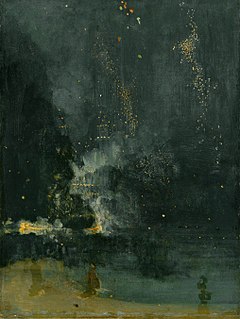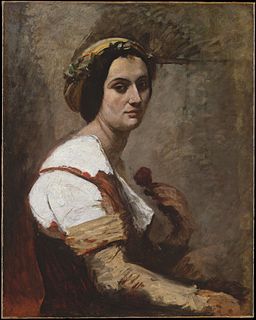 W
WThe Ballet Class is a painting by Edgar Degas, which was painted between 1871 and 1874. It is in the collection of the Musée d'Orsay, Paris, France. It was commissioned by Jean-Baptiste Faure. Degas temporarily abandoned work on this painting, and delivered a work of a similar name to Faure.
 W
WThe Café-Concert is an 1879 painting by the French painter Édouard Manet, who often captured café scenes depicting social life at the end of the nineteenth century similar to those depicted in this painting.
 W
WA Connemara Girl is an early 1870s painting by the Irish artist Augustus Nicholas Burke. One of the most identifiable paintings in Ireland, it depicts a young girl in traditional Connemara attire carrying a bundle near the shore. It is one of many paintings Burke created of daily life around his native Connemara. It hangs in the National Gallery of Ireland and is one of the more popular paintings despite its simple subject matter. The painting is oil on canvas and was presented by Mrs Ida Monahan in 1951.
 W
WL'Estaque, Melting Snow is a c. 1871 oil-on-canvas painting by French Post-Impressionist artist Paul Cézanne. It shows a view from the outskirts of L'Estaque, a small village near Marseille, with a steep hillside covered in a drift of melting snow underneath a foreboding dark grey sky. Filled with intense emotion, the painting has been described as similar to the work of Vincent van Gogh the following decade, and a painting more formally similar to early 20th-century than contemporaneous art. L'Estaque, Melting Snow was painted in a single session. It is one of only two snow-laden winter subjects Cézanne painted.
 W
WLa parisienne japonaise is an oil on canvas painting by Belgian painter Alfred Stevens. It depicts a young woman in a blue kimono standing in front of a mirror. The painting testifies to Stevens' involvement with Japonisme. Stevens was one of the earliest collectors of Japanese art in Paris.
 W
WMound of Butter is a still life painting of a mound of butter, by the 19th-century French realist painter Antoine Vollon made between 1875 and 1885. The painting is in the National Gallery of Art in Washington D.C., with the New York Times calling it one of "Washington’s Crown Jewels".
 W
WNocturne in Black and Gold – The Falling Rocket is a c. 1875 painting by James Abbott McNeill Whistler held in the Detroit Institute of Arts. The painting exemplified the Art for art's sake movement – a concept formulated by Pierre Jules Théophile Gautier and Charles Baudelaire.
 W
WNocturne: Blue and Gold – Old Battersea Bridge is a painting by the American artist James McNeill Whistler, now held in the collections of Tate Britain. It was painted around 1872–1875.
 W
WThe Poem of the Soul is a series of oil on canvas paintings by Louis Janmot, produced between 1835 and 1881 and totalling eighteen paintings and sixteen charcoal drawings, all inspired by a 2800 verse poem by Janmot himself. The first works in the series were exhibited at the 1855 Exposition Universelle. The series tells of a soul's life on earth, incarnated in a young man, accompanied by his female double. His companion then disappears and he spends the rest of his life alone, as did the artist. The series is now in the Museum of Fine Arts of Lyon.
 W
WPortrait of a Seated Woman is an oil on canvas painting by Dutch painter Nicolaes Maes. Its date of execution is unknown. Maes first recorded painting dates back to 1653. Maes, a pupil of Rembrandt, started his career as a painter of biblical and mythological subjects, genre paintings and as a portraitist. He died in 1693. The paintings measures 112,5 x 91,5 cm, and is currently housed at the Royal Museum of Fine Arts in Antwerp.
 W
WPygmalion and the Image is the second series of four oil paintings in the Pygmalion and Galatea series by the Pre-Raphaelite artist Edward Burne-Jones which was completed between 1875 and 1878. The two collections may be seen below, in the Gallery, the first being now owned by Lord Lloyd Webber, and the second housed at the Birmingham Museum & Art Gallery. This article deals with an appraisal of the second series.
 W
WThe Red Cape, also sometimes known as Madame Monet or The Red Kerchief, is an oil-on-canvas snowscape by French impressionist Claude Monet. The painting depicts Claude Monet's wife, Camille, passing outside of a window dressed in a red cape.
 W
WSibylle is a 19th-century painting by French artist Jean-Baptiste-Camille Corot. Done in oil on canvas, the painting portrays a model holding a red rose. The painting is currently in the collection of the Metropolitan Museum of Art.
 W
WStreet Scene near the El Ghouri Mosque in Cairo is a c.1876 oil and watercolour painting by the British Orientalist artist John Frederick Lewis, produced just before the artist's death. He had left Cairo around 25 years earlier after twelve years there. He based it on a drawing he had made from life between 1841 and 1851 which is now in the Courtauld Gallery in London. The final work belonged to Christopher Forbes and was among works given to the Louvre's American Friends in 2011 by Forbes' family.
 W
WThe Bath is an oil on canvas painting by Belgian painter Alfred Stevens.
 W
WThe Parisian Sphinx is an oil on canvas painting by Belgian painter Alfred Stevens. Painted between 1875 and 1877, it depicts a dreamy young woman gently supporting her head with her hand. The painting is part of the permanent collection of the Royal Museum of Fine Arts in Antwerp. The Parisian Sphinx shows the influence of Vermeer and the other Netherlandish old masters on Stevens, and testifies to the Symbolist influence in the latter's day. It incorporates a harmonious juxtaposition of superficial Dutch realism with the spreading Symbolist manner, as opposed to the bottom-up, pluralistic symbolism of the declining Romanticism. While well executed and apparently quite realistic, the painting has also a non-plain meaning.
 W
WThe Psyché is an oil on panel painting by the Belgian artist Alfred Stevens. Painted in circa 1871, the painting once belonged to Robert de Montesquiou, and is currently housed at the Princeton University Art Museum located in Princeton, New Jersey.